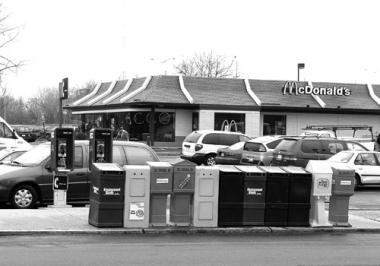When dozens of newspaper boxes disappeared from downtown Springfield last week—between 30 and 60 boxes, including seven Valley Advocate boxes—Advocate Circulation Manager Jeffrey Owczarski began calling city officials, hoping that someone in a position of authority might know where the newspapers were and why they were removed.
For two days, Owczarski made repeated calls to city officials. He called the mayor's office, seeking the assistance of Springfield's first-term mayor, Domenic Sarno. He called the Department of Public Works and the Planning Department. Of course, he called the cops.
Most of Owczarski's calls went unreturned. The police invited him to file a stolen goods report for each of the Advocate's missing boxes. If anyone in official Springfield knew the location of the missing boxes or why they'd all been removed—all, that is, except the half dozen Springfield Republican boxes that were left untouched in the downtown area—they weren't talking.
Finally, last Friday morning, three days after he discovered that the boxes were missing and following a number of phone calls to city officials from an Advocate reporter in pursuit of a news story, Owczarski found someone willing to talk.
Chris Castellano, Operations Manager for the Springfield Business Improvement District, a non-profit corporation that works to beautify and promote 10 blocks of downtown Springfield, told Owczarski that he and he alone had removed the boxes, storing them on property owned by Peter Pan Bus Lines on the corner of Main Street and Liberty Street. Castellano told Owczarski that he'd talked to city Principal Planner Scott Hanson about removing the boxes during a recent construction project in downtown Springfield. He said that he had mistaken Hanson's expressed desire to be rid of the newspaper boxes for permission to haul them away.
"It didn't really come down from above," Castellano said in a subsequent interview with the Valley Advocate, referring to the plan to remove the newspaper boxes. "I take the blame. I take full responsibility. It was stupid and I've already caught a lot of shit for it from my boss."
Castellano's boss, SBID Executive Director Jeff Keck, finally returned repeated calls from Owczarski and the Advocate late Friday, leaving a voice message that essentially confirmed Castellano's claim that the boxes had been removed "three to four weeks ago" because they were in the way of construction crews that were repaving parts of Main Street.
At least in the case of the missing Advocate boxes, Castellano could not have removed them from downtown three or four weeks ago. On Friday, after telling Owczarski that he'd taken the boxes to a storage facility on Peter Pan property, Castellano and a colleague began moving boxes back onto the streets. Mid-afternoon on Friday, Owczarski found dozens of newspaper boxes lined up along the streets adjacent to the storage area—on the far edges of downtown Springfield. The Advocate boxes still contained last week's newspaper, which had been stocked by the circulation department on Thursday, April 3—two weeks after construction projects on Main Street had been finished.
In a interview on Monday, April 14, Keck said that it was his understanding that the boxes had been removed on Monday, April 7.
Castellano acknowledged that he was not only motivated to move the boxes because of the construction project. "Part of the problem we're having is that we keep hearing from people who are having trouble with some of the boxes not being maintained," Castellano said. "Some of the boxes had papers going back to January. It seems that nobody has maintained them. I got aggravated. I moved them so that somebody would do something about them."
"I know now that that wasn't the right thing to do," Castellano added.
In fact, the boxes owned by the Advocate and the Weekly Reminder publications were in good shape. The purge included 10 other publications, including the Employment Guide and Healthcare News.
Castellano offered a reason the Springfield Republican boxes were left untouched: "They had money in them. We didn't touch anything with money."
Initially contacted by the Advocate before Castellano claimed responsibility for taking the boxes, Assistant Director of Planning Philip G. Dromey said he didn't know what had happened. "I know they're gone," he said, referring to the missing boxes, "but I don't know why or who. I know we had just redone Main Street, but I can tell you that [the directive to remove the boxes] didn't come out of this office."
In a subsequent voice message, Dromey acknowledged that there had been discussions between SBID and the planning department's Scott Hanson "regarding an overall strategy about boxes, but there was no authorization from this office. It was not a planning department request [to remove the boxes]."
Hanson, according to the planning department, is on vacation until April 22.
Six of the seven Advocate boxes were put back on the streets on Friday. Castellano assured Owczarski that the remaining box would be replaced by Monday. Owczarski, who monitored the situation over the weekend, said that none of the other boxes have been returned.
From the SBID website (www.springfielddowntown.com), it's clear that the organization, acting as a quasi-governmental agency, hopes to present an image of Springfield that bears little similarity to the city as it really looks. While its effort to beautify the downtown may be public-spirited, SBID's apparent disregard for the First Amendment protections of newspapers suggests, at the very least, the need for greater oversight by the city. Unfortunately, Springfield's mayor demonstrated little urgency in finding out what happened here and why it happened. Sarno has yet to return repeated calls seeking comment.



